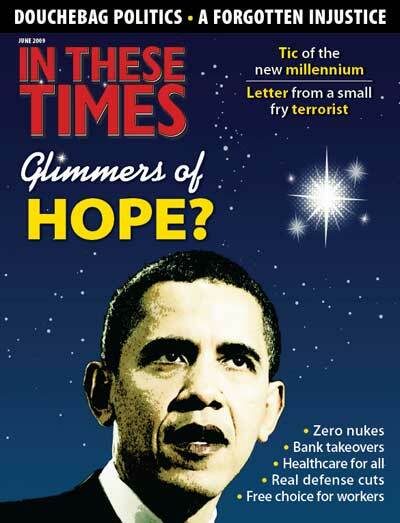
President Obama committed to making a major legislative push for healthcare reform in his first year in office. But there is reason to worry that any potential reform may look more like the recent bank bailouts – that is, a massive giveaway to politically connected corporations – than a progressive restructuring of the U.S. healthcare system.
By substantial majorities, both voters and doctors in the United States favor a Canadian-style, single-payer healthcare plan that would dethrone private insurance companies from their commanding role in the current system.
But despite this fact, most healthcare reform lobbying and rhetoric has excluded the single-payer option from the debate, leaving for-profit insurance companies at the heart of the U.S. healthcare system.
Guaranteed profits?
Rather than pursue a single-payer system, the Obama administration, the insurance industry, unions and citizen groups have settled upon the “guaranteed affordable choice” model, which would mandate that all Americans purchase health insurance or enroll in some version of a public plan. The mandate would be coupled with an agreement by insurers to stop rejecting applicants because of “pre-existing conditions.”
But many health experts argue that insurers have shown enormous ingenuity in avoiding patients who are older or have conditions that will be expensive to treat. Companies manipulate sign-up procedures, avoid marketing in settings where older people are likely to be and delay authorization or payment for treatments, Harvard Medical School’s Dr. David Himmelstein told In These Times.
If enacted, this “affordable choice” system would likely be an enormous windfall for the health insurance industry by adding tens of millions of new enrollees.
“The one model [single-payer] that works is being set aside right from the start as ‘not politically feasible,’” says Chris Townsend, political director of the United Electrical Radio and Machine Workers. “But somehow a Rube Goldberg scheme, requiring mandatory purchase of insurance, gets certified as politically viable.”
Still, the labor-consumer coalition Health Care for America Now (HCAN) – composed of roughly 30 groups, including the AFL-CIO, the Service Employees International Union (SEIU), USAction, MoveOn.org and La Raza – has aggressively attacked the single-payer approach, citing focus groups and dubious polling. In his book, Obama’s Challenge, progressive economist Robert Kuttner criticizes the promotion of “guaranteed affordable choice,” noting that HCAN’s pollsters “put a subtle thumb on the scale in the way they worded the descriptions of the various approaches that were read to the focus groups.”
Senate Finance Chair Max Baucus (D-Mont.), one of the most powerful members of Congress, already ruled the single-payer option “off the table.” The reason, he explains: “We are Americans. We’re different from Canada, we’re different from the United Kingdom.”
For Baucus, the vital difference is not that U.S. citizens pay double what Canadians and citizens of other advanced nations pay in return for a healthcare system ranked 37th by the World Health Organization. Instead it is Americans’ supposed preference for a system directed by for-profit insurers. Never mind that more than 40 million Americans already experience a single-payer system via Medicare, which permits a free choice of doctors and uses government leverage to hold down costs.
In Obama’s Challenge, Kuttner argues that reform stopping short of a single-payer system will lead to both worsening U.S. healthcare coverage and rising costs. “The assumption that a single, comprehensive system is politically out of the question puts America on a path that would combine nominal universal coverage with deterioration in what is actually covered, plus acceleration of cost-shifting to individuals,” he writes.
Unanswered questions
But arguments like Kuttner’s have yet to penetrate the armor of the juggernaut lobbying for the “affordable choice” model.
The for-profit players bring to the table an overwhelming array of political resources – campaign contributions, lobbyists, and the ability finance “astro-turf” campaigns that mimic the style of authentic grassroots efforts while being carefully shaped by corporate interests.
Some unions, most notably SEIU, argue that working with insurers and industry groups is a political necessity given the enormous power of the insurance industry. Speaking to In These Times, an SEIU spokeswoman proudly enumerated the high-profile members of a broad “affordable choice” alliance to promote a modest form of healthcare reform that was built through several SEIU-affiliated coalitions: Wal-Mart, AT&T, Intel, Manpower, the American Medical Association, the American Hospital Association, America’s Health Insurance Plans (AHIP), the U.S. Chamber of Commerce, the National Association of Manufacturers and the conservative Business Roundtable.
Even within these companies and groups, however, thorny issues remain unresolved-especially the nature of the public option. Influential reform voices argue strenuously that the public plan should be a Medicare-style system that can serve as benchmark competition, keeping doctor and hospital prices in check.
Members of the Congressional Progressive Caucus, who generally favor a single-payer system, met with President Obama in late April to stress that the public option must be modeled upon Medicare. Caucus members are adamant that the public option serve as an attractive, nonprofit alternative to private insurance and that reform legislation must give states the option of enacting their own single-payer plans.
But medical industry interests and congressional Republicans appear intent on drawing a line in the sand. They argue that a Medicare-based plan would constitute unfair competition. Karen Ignagni, executive director of AHIP, insists: “There’s no way to run a side-by-side competition within the current structure.”
Similarly, Billy Tauzin, political director of Pharmaceutical Research and Manufacturers of America, has said that a government-run option would be a slippery slope. “The government becomes a price fixer, and it will drive out private offerings,” Tauzin told Politico.com in March 2008. “It ends up being a single-payer system eventually.”
Single-payer advocates view these statements as an admission that a single-payer plan would be much more streamlined and cost-efficient. “It’s funny for them to admit the public plan is unfair because it’s more efficient,” says Dr. Don McCanne, of Physicians for a National Health Plan (PNHP).
Private health companies, McCanne believes, would like a system in which they can insure the young and healthy while pushing expensive care into the government plan. “That way, they can continue to collect premiums and [not] provide service,” he says.
United Electrical’s Chris Townsend believes that the future of healthcare reform comes down to Obama’s political will. Townsend asks: “Is Obama willing to have a political collision with the private interests that have driven the nation into the ditch on one issue after another?”
The answer to that question should be much clearer later this year.
GET INVOLVED
Physicians for a National Health Plan, 312−782−6006Health Care for America Now,202-454-6200
California Nurses Association/ National Nurses Organizing Org,510-273-2200
Health Care Now!, 1−800−453−1305
Progressive Democrats of America, 877−239−2093
Leadership Conference for Guarantee Health Care (aka National Single Payer Alliance)









